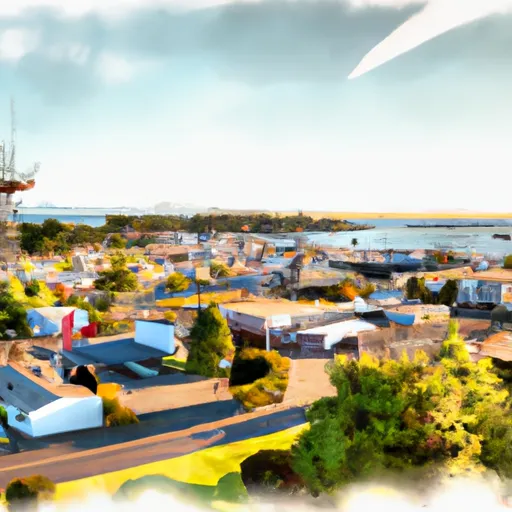-
 Snoflo Premium
Snoflo Premium
Get unlimited access to all our content
With no Ad interruptions! - Start Your Free Trial Login with existing account
Oak-Harbor
Eden Index
Climate
7.6
•
Recreation
7.2
•
Community
2.5
•
Safeguard
6.2/10

Oak Harbor is a charming city located on Whidbey Island, Washington. With a mild marine climate, Oak Harbor experiences cool, wet winters and warm, dry summers. It boasts a beautiful coastline and is surrounded by the Salish Sea, which makes it a haven for water enthusiasts. The hydrology constituents in this area mainly include the Skagit River, the Swinomish Channel, and the Strait of Juan de Fuca. Outdoor enthusiasts can take advantage of various recreational opportunities, including boating, fishing, kayaking, and whale watching. Deception Pass State Park is a popular destination, offering stunning hiking trails, camping sites, and breathtaking views of the Deception Pass Bridge. Nature lovers will also enjoy exploring the nearby Ebey's Landing National Historical Reserve, known for its scenic beauty and diverse wildlife.
What is the Eden Index?
The Snoflo Eden Index serves as a comprehensive rating system for regions, evaluating their desirability through a holistic assessment of climate health, outdoor recreation opportunities, and natural disaster risk, acknowledging the profound impact of these factors on livability and well-being.
Climate Health Indicator (CHI): 7.6
Oak-Harbor receives approximately
542mm of rain per year,
with humidity levels near 82%
and air temperatures averaging around
10°C.
Oak-Harbor has a plant hardyness factor of
8, meaning
plants and agriculture in this region tend to thrive here all year round.
By considering the ideal temperature range, reliable water supplies, clean air, and stable seasonal rain or snowpacks, the Climate Health Indicator (CHI) underscores the significance of a healthy climate as the foundation for quality living.
A healthy climate is paramount for ensuring a high quality of life and livability in a region, fostering both physical well-being and environmental harmony. This can be characterized by ideal temperatures, reliable access to water supplies, clean air, and consistent seasonal rain or snowpacks.
Weather Forecast
Streamflow Conditions
Puget Sound
Area Rivers
Puget Sound
Snowpack Depths
Puget Sound
Reservoir Storage Capacity
Puget Sound
Groundwater Levels
Recreational Opportunity Index (ROI): 7.2
The Recreational Opportunity Index (ROI) recognizes the value of outdoor recreational options, such as parks, hiking trails, camping sites, and fishing spots, while acknowledging that climate plays a pivotal role in ensuring the comfort and consistency of these experiences.
Access to outdoor recreational opportunities, encompassing activities such as parks, hiking, camping, and fishing, is crucial for overall well-being, and the climate plays a pivotal role in enabling and enhancing these experiences, ensuring that individuals can engage in nature-based activities comfortably and consistently.
Camping Areas
| Campground | Campsites | Reservations | Toilets | Showers | Elevation |
|---|---|---|---|---|---|
| Upper Forest - Fort Worden State Park | 30 | 54 ft | |||
| Fort Townsend State Park | 40 | 247 ft | |||
| Larrabee State Park | 75 | 134 ft | |||
| Jefferson County Fairgrounds | 80 | 17 ft | |||
| Bay View State Park | 80 | 37 ft | |||
| Fort Worden State Park | 80 | 173 ft | |||
| Beach - Fort Worden State Park | None | 15 ft | |||
| Camano Island State Park | 88 | 181 ft | |||
| Fort Flagler State Park | None | 100 ft | |||
| Fort Casey State Park | 35 | 11 ft |
Nearby Ski Areas
Catastrophe Safeguard Index (CSI):
The Catastrophe Safeguard Index (CSI) recognizes that natural disaster risk, encompassing floods, fires, hurricanes, and tornadoes, can drastically affect safety and the overall appeal of an area.
The level of natural disaster risk in a region significantly affects safety and the overall livability, with climate change amplifying these risks by potentially increasing the frequency and intensity of events like floods, fires, hurricanes, and tornadoes, thereby posing substantial challenges to community resilience and well-being.
Community Resilience Indicator (CRI): 2.5
The Community Resilience Indicator (CRI) recognizes that education, healthcare, and socioeconomics are crucial to the well-being of a region. The CRI acknowledges the profound impact of these elements on residents' overall quality of life. By evaluating educational resources, healthcare accessibility, and economic inclusivity, the index captures the essential aspects that contribute to a thriving community, fostering resident satisfaction, equity, and social cohesion.

